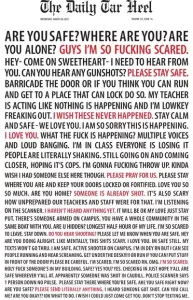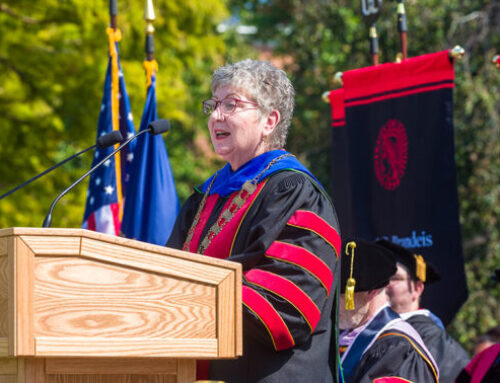By Anna Williams
When will the violence stop?
I kept asking myself this question as I read about the monstrosities that occurred at the University of North Carolina (UNC) on August 28th. As an empath, I immediately felt what my brain could conceive as the terror that those students, staff, and faculty felt when they heard gunshots, saw people running, and felt their hearts drop as they realized their school was the next school shooter incident.
What I didn’t realize I would feel was anger.
Anger towards the young man who took someone’s life for no justifiable reason. Anger towards the institution that failed to communicate what was occurring to those under attack during an unimaginable situation. After processing these feelings and realizing that violence in this world is unfortunately inevitable, I began to ask myself another question: What will it take to minimize the number of victims as a result of school shootings?
A campus in grief
Tailei Qi, a graduate student in the UNC Department of Applied Physical Sciences, shot his professor Zijie Yan. Although the two of them were fairly close — they co-wrote research papers together — this didn’t stop him from pulling the trigger of his 9mm handgun.
Law enforcement has not discovered a motive yet. Not that a motive would offer relief for the pain that Yan’s loved ones feel as they live another day without her. However, a motive could offer some insight into potential warning signs that the university can address to prevent another tragedy from occurring.

Photo Courtesy // Hannah Schonenbaum, The Associated Press
The failed UNC protocol
Unfortunately, everyone is familiar with standard active shooter drills and training. For example, barricading yourself in a room with desks or hiding in a bathroom stall on the toilet. However, if a real situation occurs, as it did at UNC, the standard may become subpar.
There is plenty of specialized research and training in school shootings that experts have conducted. This is important because as Dr. Mary Ellen O’Toole, Supervisory Special Agent of the Federal Bureau of Investigation, states, “Youth violence has been one of the greatest single crime problems we face in this country”. However, those resources aren’t always taken seriously or actively practiced in institutions.
Many complaints about the transparency of information from UNC administrators have transpired since that tragic day. Although UNC did an excellent job at informing those on campus of what was occurring in real time, there was confusion among students, staff, and faculty when UNC’s alert system Alert Carolina sent messages to those on campus to stay “sheltered in place.” What exactly does “sheltered in place” entail? Did the campus community have training on such a method of survival? According to an article written by The Daily Tar Heel, UNC’s student-run newspaper, some students claimed that they hadn’t had training over that specific command and that they relied on their innate intuition to survive the incident.

August 30th’s front page of The Daily Tar Heel Photo Courtesy // The Daily Tar Heel
Acceptance is paramount
I will not claim to be an expert on school shooter protocol and offer the “solution” to prevent school shooters from taking the lives of anyone ever again. Violence has been present in this world since the beginning of time and will continue until the end of time.
However, as a person who has read too many stories about innocent people losing their lives to someone behind a gun at their place of work or education, I do believe that any and every resource available to educate people about how to survive a shooting should be the focus of institutions. It is time for institutions to accept the fact that what happened at UNC, and 12 other universities and colleges since 1966, can happen at their school. School prestige and popularity will not act as a shield against gun violence.
Even though the violence may not stop, neither will the initiative to survive. Students, staff, and faculty: advocate for the best chances of your survival by demanding more intensive, frequent active school shooter training from your school. Challenge the standards of school shooter safety protocols and take your survival into your own hands, as it is apparent institutions fail to recognize the importance of the effects that school shootings have.
Photo Courtesy // The Daily Tar Heel; Hannah Schonenbaum, The Associated Press





